# Quick Start Guide
Welcome to Imunify Email, a powerful plugin designed to enhance your Imunify360 experience with advanced email protection features such as:
- Advanced Server Protection: Provides robust protection against outgoing spam, ensuring your server maintains a high reputation and reliable email delivery.
- Rate-Limit Settings: Allows you to define how many messages can be sent on behalf of specific accounts, domains, emails, or scripts, helping to prevent abuse and maintain control over email traffic.
- BETA: Incoming Filtration: A new feature, currently in beta, that can be enabled to protect your users from incoming spam. Learn more about enabling this feature here.
# Installation Steps
Requirements
- cPanel
- Imunify360
Install Imunify360
Imunify Email is a plugin for the Imunify360 product. To use Imunify Email, you must first install Imunify360. Follow the installation instructions for Imunify360 to get started.
Enable Imunify Email in CLN
Once Imunify360 is installed and registered, you can enable the Imunify Email plugin through the CLN (CloudLinux Network) portal. This will automatically install all necessary components. Follow the instructions to enable Imunify Email in CLN. For the system requirements and installation steps, refer to the Installation.
# Full Documentation
# Imunify Email compatibility
Imunify Email has been checked for compatibility with following tools and mail gateways:
- Config Server Services
- MailChannels from IE 0.6 version
- SpamAssassin (incoming and outgoing configuration)
- Smtp2go
# Installation
Note
Hosting administrator only. Imunify Email requires Imunify360 to be installed on the server.
Ensure that port 11335 is open. Additionally, note that it is a UDP server, and therefore, it is not accessible via telnet.
Imunify Email is simple to install. At the moment, it runs on the following distributions:
- CentOS 7, 8 with support of cPanel/WHM control panel.
- CloudLinux OS 7, 8, 9 with support of cPanel/WHM control panel.
- AlmaLinux 8, 9 with support of cPanel/WHM control panel.
Minimum system requirements for installation:
x64 | 512 Mb | 20 Gb disk space
Note
Imunify Email RAM consumption depends on the mail traffic. In a waiting state it consumes little RAM, however for scanning large mails temporary increase of RAM consumption can be observed.
Used disk space depends on the number of accounts on a server. By default, each account will have 100 MB limitation for quarantine space. This limit can be adjusted using UI later.
To install Imunify Email, you need to enable the corresponding option in your CLN account. After that the product will be installed automatically within 24 hours. To install it immediately you can use on of the following command as root user:
/usr/bin/imunify360-agent update-license
or
wget https://repo.imunify360.cloudlinux.com/defence360/imunifyemail-deploy.sh
bash imunifyemail-deploy.sh
# Details
# Users created
During installation, the following users will be created:
- _rspamd
- _imunifyemail
The _imunifyemail user will also be added to the _imunify group.
# Components and resources
Imunify Email has the following components:
- Imunify RSpamd
- acts as an email filter
- it is installed in system directories such as /etc/rspamd, /usr/bin, /usr/lib, /usr/share/rspamd, as a part of
imunify-email-rspamdRPM package and bringsrspamdservice
- Quarantine (ie-quarantine)
- acts as a storage for quarantined emails and as a back-end for the user interface (UI) and CLI
- it is installed in the /var/imunifyemail/quarantine directory, as a part of
imunify-email-quarantineRPM package and bringsie-quarantineandie-notificationservice.
- CLI (ie-cli)
- it is a command line interface for managing Quarantine and Activity Monitor that is installed as a part of
imunify-email-cliRPM package
- it is a command line interface for managing Quarantine and Activity Monitor that is installed as a part of
- Dec Node (ie-dec-node)
- it is a statistical component that helps to improve the filtering quality
- it is installed in the /var/imunifyemail/dec-node directory, as a part of
imunify-email-dec-nodeRPM package and bringsie-dec-nodeservice
All these packages are installed as part of imunify-email RPM package.
# Exim configuration modifications
Imunify Email modifies Exim MTA configuration, adding RSpamd as a filter for email. It is done automatically during installation. In case if filtering needs to be disabled, see Disable Imunify Email. When disabled, Exim configuration will not contain an RSpamd filter. To re-able Imunify Email, see Enable Imunify Email.
The configuration change is compatible with WHM Advanced Editor, you can continue using it for other modifications.
# CLN: Managing Imunify Email
# How to Enable Imunify Email
# Background
In order to use ImunifyEmail you have to enable it in CLN. You can achieve it in two ways:
- via CLN UI
- via CLN API
When you enable/disable Imunify Email, the script will automatically run the corresponding action within 24 hours. In order to apply changes on the particular server immediately, please run the following command on behalf of the root user:
imunify360-agent update-license
# CLN UI: enable/disable Imunify Email
You can manage Imunify Email state on 3 levels: Account, Key, Server.
# 1. Account
To manage permission on an account level choose the “Enable for all servers” option.
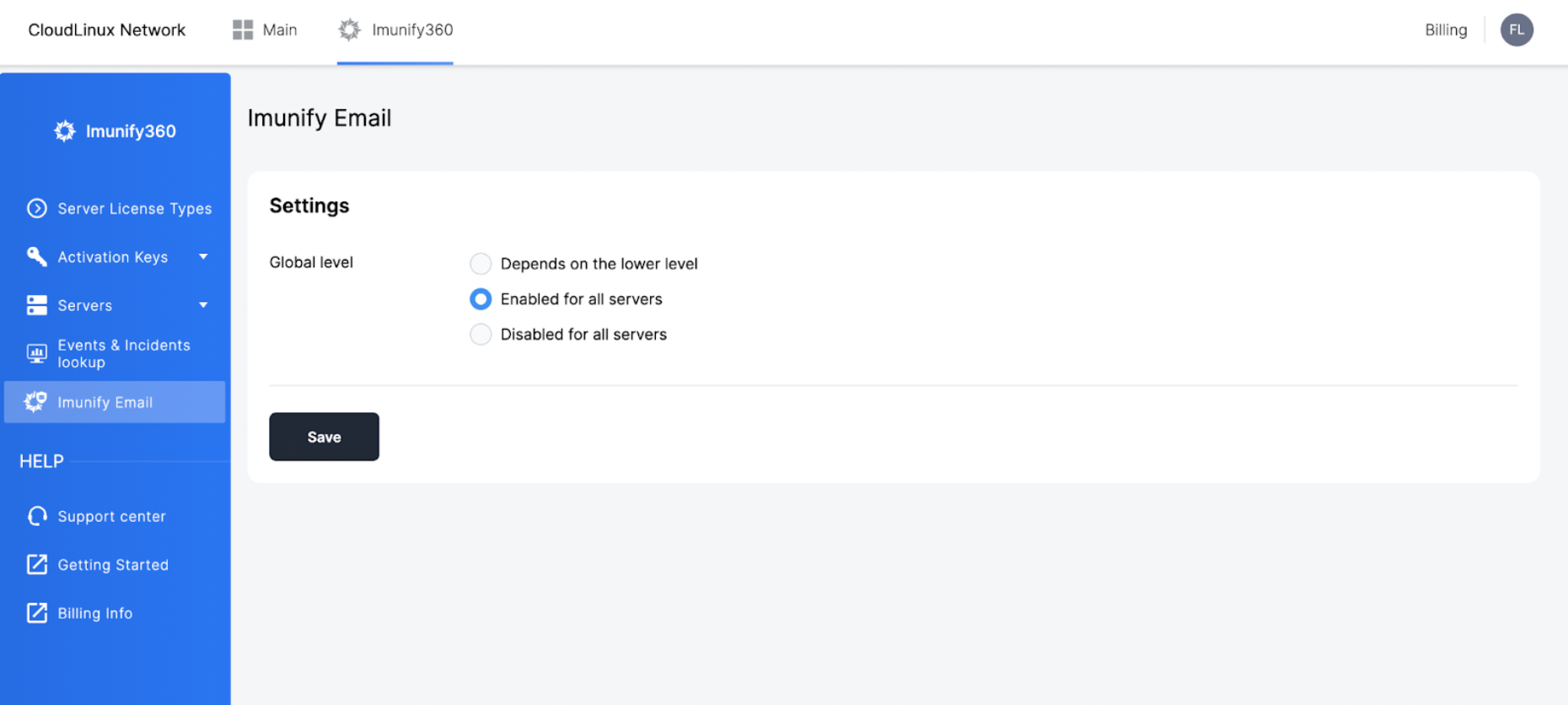
When you enable the feature on an account level, the script will install Imunify Email on all Imunify360 servers in your account in 24 hours.
When disabling the feature on an account level, the script will deactivate the Imunify Email on all Imunify360 servers in your account in 24 hours.
There's also a default option called “depends on lower level”. This allows you to control permissions based on each key or license, rather than for the whole account.
# 2. Key
To manage permission on a key level go to the “Activation keys” tab and select “add-ons”.
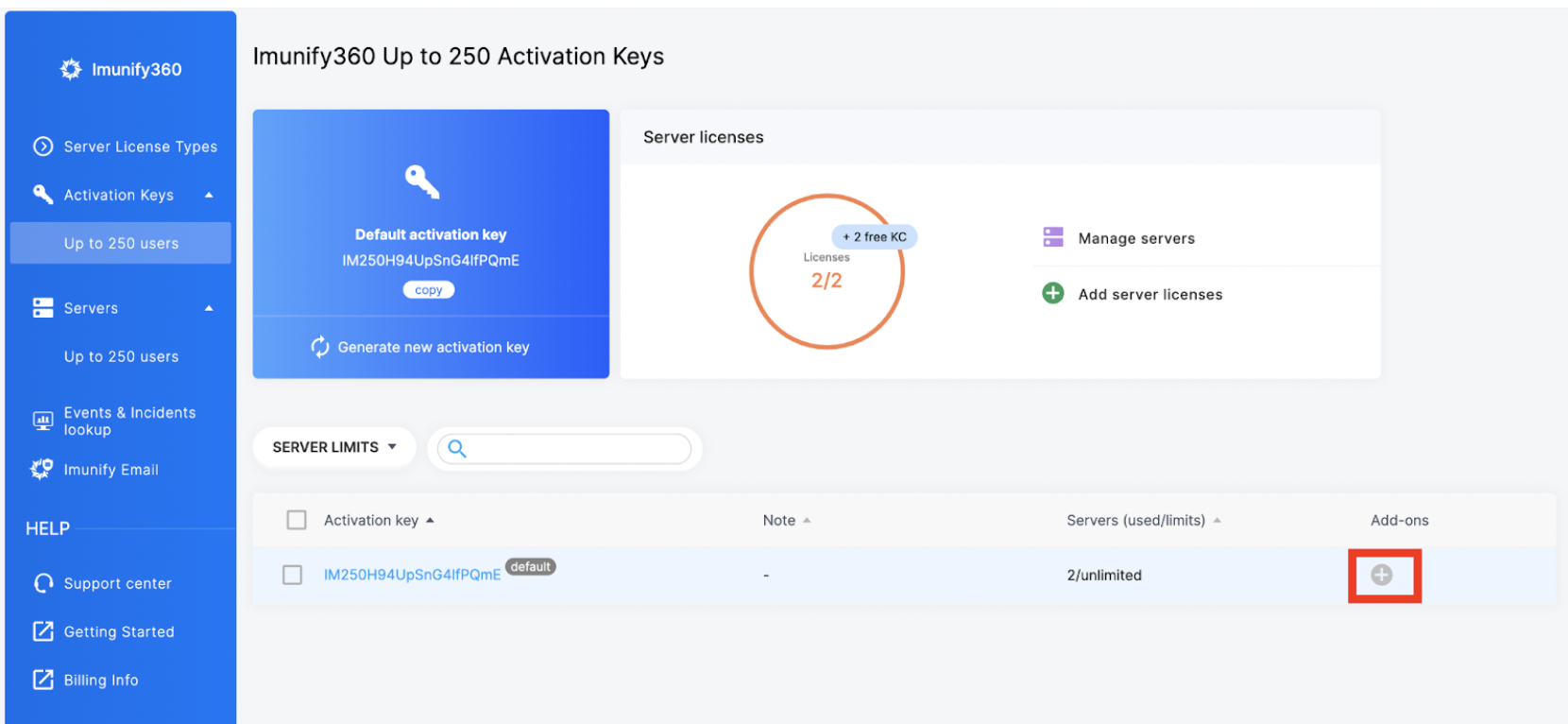
You will see this screen:
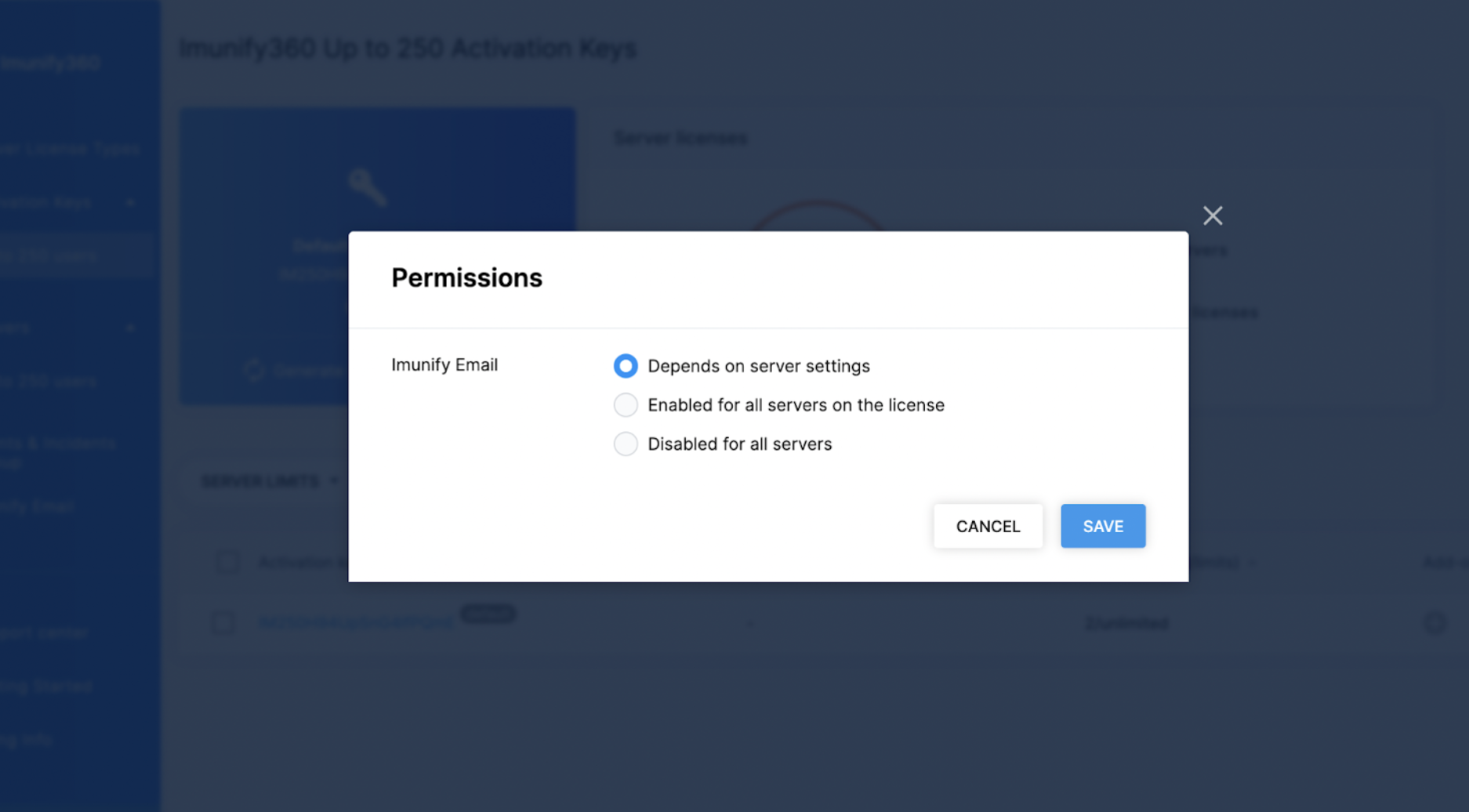
When you enable the feature on all servers in the key, the script will install Imunify Email on all Imunify360 servers under this key in 24 hours.
When disabling the feature on a key level, the script will deactivate the Imunify Email on all Imunify360 servers under this key in your account in 24 hours.
There's also a default option called “depends on lower level”. This allows you to control permissions based on each server.
# 3. Server
To manage permission on a server level. Go to the “Servers” tab and select “add-ons”.
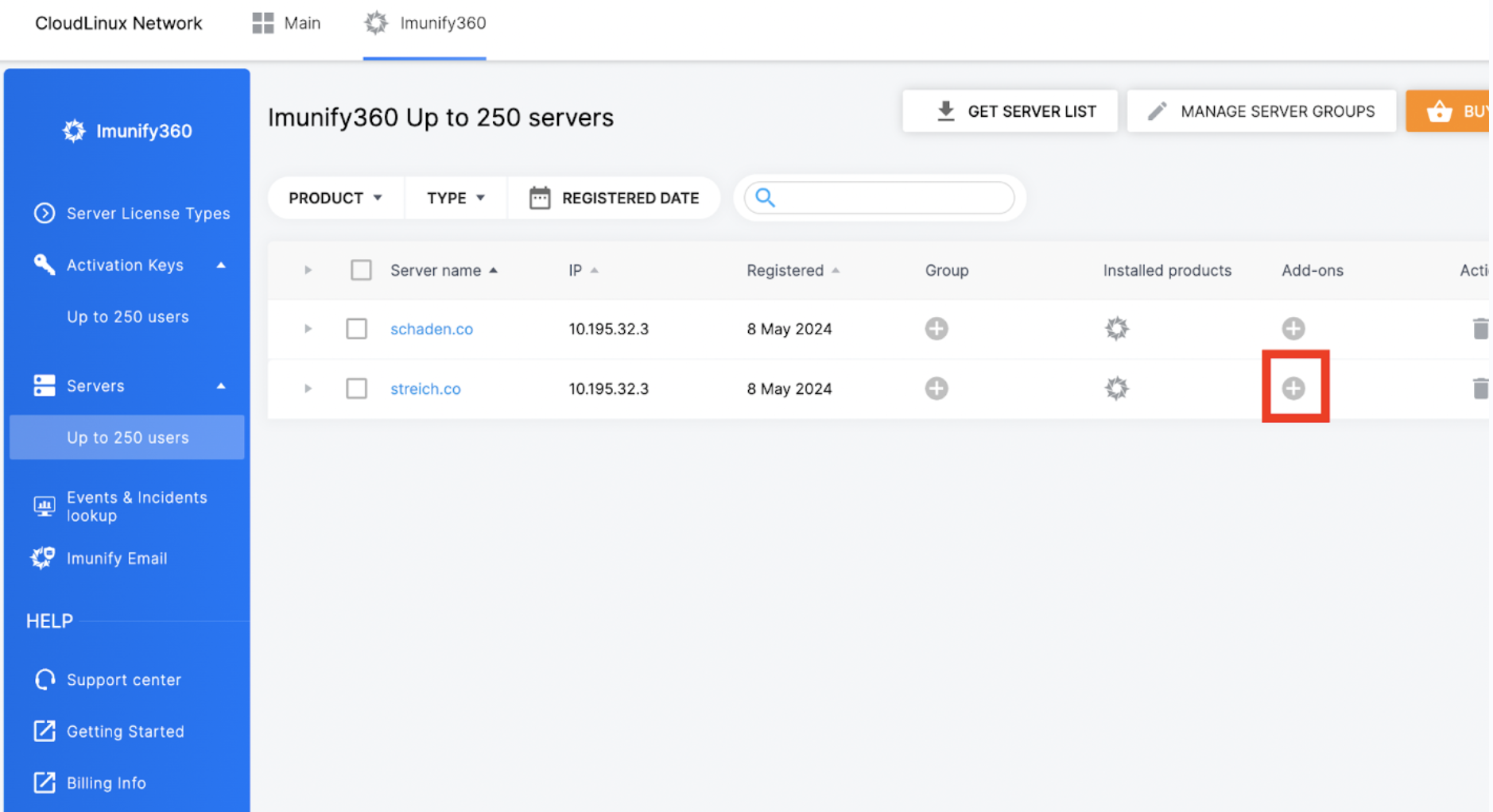
You will see this pop up:

When you enable the feature, the script will install Imunify Email on a server in 24 hours.
When disabling the feature, the script will deactivate the Imunify Email on a server in 24 hours.
# CLN API: enable/disable Imunify Email
Useful links:
- CLN API documentation (page 30 is about Imunify Email)
- CLN API swagger file
Imunify Email state is managed by the next requests:
PATCH /api/v2/features/account: to enable/disable Imunify Email for account.PATCH /api/v2/imunify/keys: to enable/disable Imunify Email for Imunify360 key.PATCH /api/v2/imunify/server: to enable/disable Imunify Email for server with Imunify360.
In CLN terms Imunify Email is a "feature" and it has id=4600.
Below is a example of how to enable Imunify Email for particular server:
- Generate API token:
$> token=$(login=YOUR_CLN_LOGIN; ts=$(date +"%s"); secret=YOUR_CLN_SECRET; echo -n $login\|$ts\|$(echo -n $secret$ts| sha1sum) | cut -d " " -f1)
- Get product names to product type id mapping:
$> curl -X 'GET' -H 'accept: application/json' -H 'Content-Type: application/json' \
'https://cln.cloudlinux.com/api/v2/ip-license/licenses/types?token=YOUR_TOKEN’
- Enable Imunify Email using its product type id (from the previous request) on a server using IP license:
$> curl -X 'PATCH' -H 'accept: application/json' -H 'Content-Type: application/json' \
'https://cln.cloudlinux.com/api/v2/imunify/server?token=YOUR_TOKEN' \
--data '{"id": "SERVER_ID_HERE", "permissions": {"4600": "ENABLED"}}'
Where "4600" the Imunify Email's feature id.
To enable Imunify Email on account/key level you have to follow almost the same algorithm but use endpoints (1)/(2) (refer to documentation above to get more details).
# Beta: Incoming Emails Filtration
Highlights
ImunifyEmail now includes a beta feature for incoming email filtration, aimed at protecting server users from spam emails. This feature is currently in beta mode and is free to use.
# Enabling/Disabling Incoming Filtration
To enable the incoming filtration feature, the server administrator needs to run the following command from the console:
ie-config enable-incoming
To disable, run the following command:
ie-config disable-incoming
Once you enable the feature, ImunifyEmail will start filtering incoming emails. Additionally, the UI in cPanel will be updated with the following changes:
- Quarantine Tab: A new column will be added to show the email direction (whether the email is outgoing or incoming).
- Settings Tab:
- A toggle will be available to disable the incoming filtration feature for specific cPanel accounts.
- A table will be added to display statistics of incoming emails, showing the number of spam and ham emails by day.
- Statistics Tab: A new section will be added to display detailed statistics of incoming emails, including the number of spam and ham emails over time.
The ie-cli utility reflects the same API as the UI, allowing customers to retrieve quarantine and statistics information via the command line interface. Use --help to get more info.
# User interface access
In order to access the UI as a hosting administrator, navigate to WHM -> Plugins -> Imunify360 -> Email tab.
Your clients will be able to access the Imunify Email Quarantine under: cPanel -> Security -> Imunify360 -> Email.
# Version and Status
# Check Imunify Email version
To find out which version of Imunify Email is installed, run the following command as root:
ie-config version
# Check status
In order to check status of Imunify Email, run the following command as root:
ie-config status
# Disable Imunify Email
In order to disable Imunify Email, you need to disable the corresponding option in your CLN account. Imunify Email will be disabled automatically within 24 hours. To disable it immediately, run following command as root:
/usr/bin/imunify360-agent update-license
It will remove filter configuration and stop Imunify Email services.
# Enable Imunify Email
If Imunify Email was installed, but then disabled it can be re-enabled in CLN.
# WHM user interface
Note
Hosting administrator only.
Imunify Email scans the outbound emails on the server and allows to identify viral mailings and other viral outbound mail content for all accounts on the server.
Click Email in the main menu of the Imunify360 admin interface.

The following tabs are available:
# Quarantine
Go to Imunify360 → Email → Quarantine tab. Here, there are emails that are considered viral or malicious for all accounts on the server. You can decline or confirm the Imunify Email decision and either release and send emails or remove them completely.
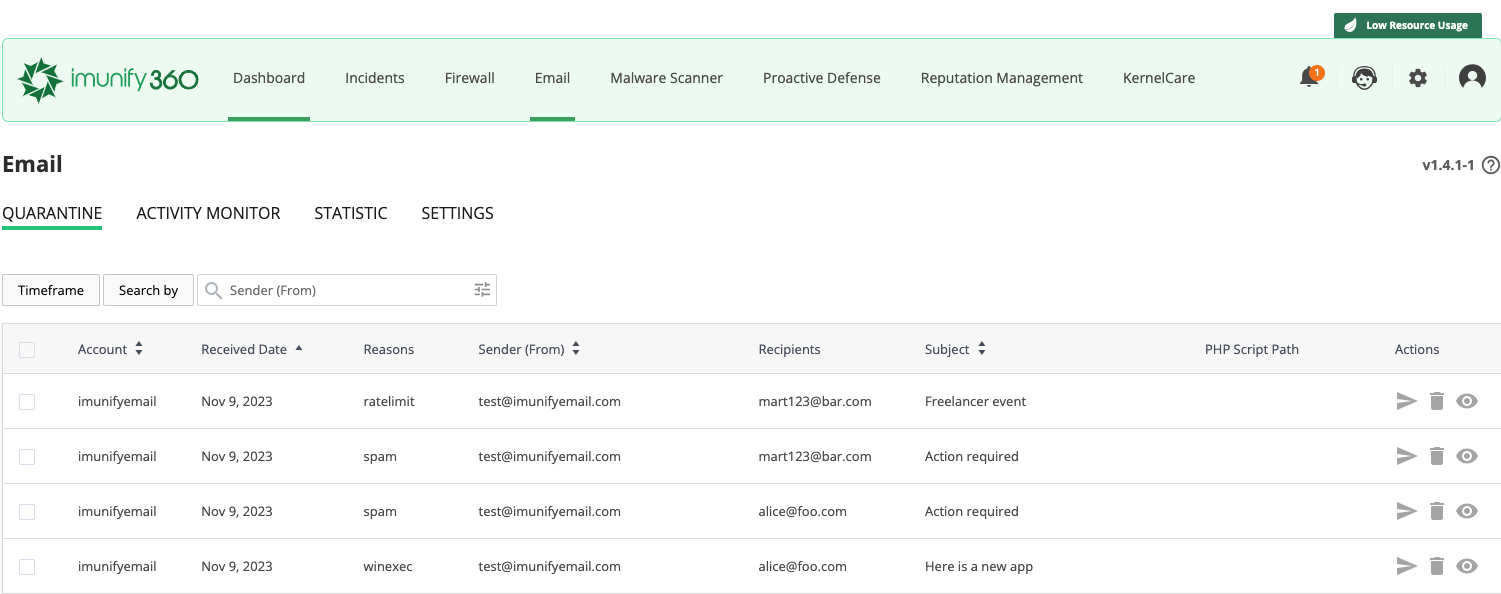
The table has the following columns:
Account — account name
Received Date — when an email was received by the server for sending
Reasons — the reason why message has been quarantined
- spam — means that a message has been classified as a spam
- winexec — means that a message contains windows executable attachments (you can allow that using ie-cli)
- ratelimit — means that a message exceeded a limit per hour for one of the Account/Domain/Sender email/Script. You might adjust the limit using the "Activity Monitor" tab.
Sender (From) — the user who sent the email
Recipients — recipients (including CC and BCC)
Subject — a subject from an email
Actions
- Release & Send — hosting admin can use multi-select and release & send several emails at once

Delete — delete email permanently
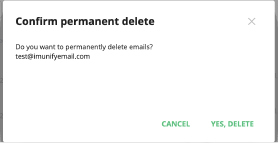
View Email — view email content
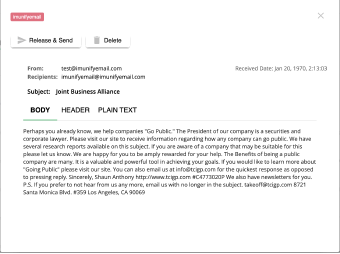
- Body - decoded email content with tags removed
- Header - email Headers section
- Plain text - headers plus original email body
Note
In this release, the notifications are not sent both when deleting or releasing an email. Will be added in the next release.
# Activity Monitor and Sender limits
Go to Imunify360 → Email → Activity Monitor. Activity Monitor provides a way to observe, control and regulate the flow of mail. From this tab the messages can be whitelisted or chosen to be explored in the Quarantine tab.
The table lists the following columns:
- Sender Object - a set of origination information that can be identified about an email is shown here. The four possible categories are:
- WHM account
- Domain
- PHP Script (able to send an email)
- Email address of a user
- Ham/Sent out - quantity of a non-spam emails that were sent out is shown corresponding to a Sender Object in a first column.
- Limit - the number of emails that corresponding Sender Object will be allowed to send out in a space of one hour. This number turns red and a warning sign is displayed as soon as the limit is exceeded.
- Whitelisted - the records in this column only have two states "true" and "false" and show if the whitelisting is on or off for a particular Sender Object.
- Quarantined - reflects emails from a particular Sender Object and their quantity.
- Actions - several actions to perform on a particular Sender Object are available:
- Go to quarantine allows to explore a particular Sender Object in a Quarantine tab.
- Update sender limit allows to enable/disable granular limits for a particular Sender Object that override limits set in the Settings tab.
- Whitelist sender allows to remove any limit on sending out emails for a particular Sender Object.

The Timeframe setting for the records visible in the table can be chosen from the following options under the Timeframe button.
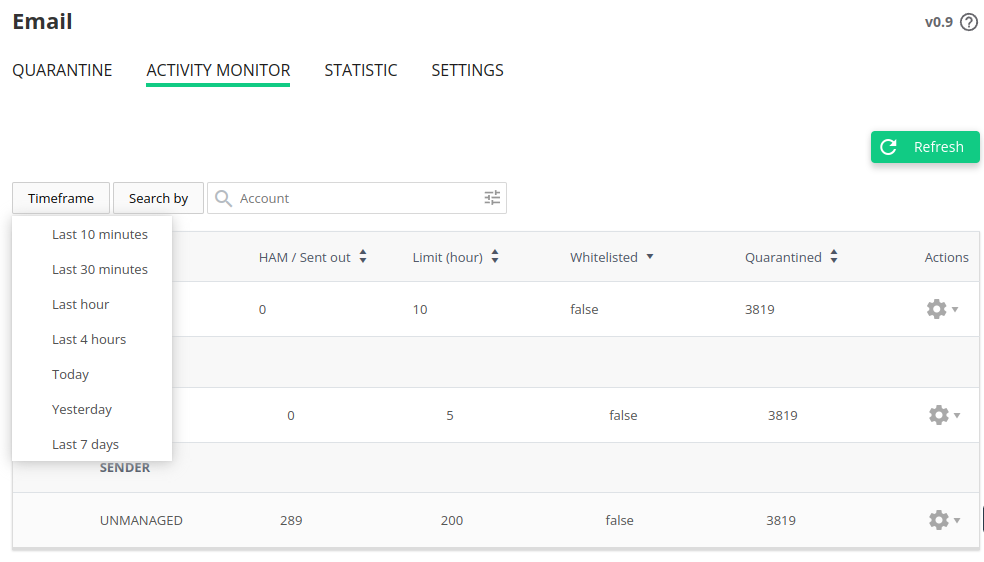
Records in the table are searchable and the parameters of the search can be narrowed down by using the Account name, Sender address, Domain, and Script filters.

# Sender limits
This is the second level of control for sender limits. Limits set for a particular Sender Object here override the limits set on the previous stage.
Go to Imunify360 → Email → Activity Monitor → Actions → Update sender limit. For a particular Sender Object the limit can be switched on and off. The limit value can be set higher or lower than the value in the Setting tab. This setting is aimed at providing a way to set needed exceptions from the general rules.
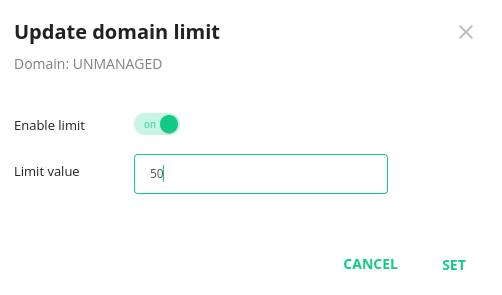
# Whitelisting
This is the third level of control for sender limits. Limits set via this control override the limits set at the two the previous stages. Go to Imunify360 → Email → Activity Monitor → Actions → Whitelist sender. A particular Sender Object can be whitelisted, which means that the Sender limits will no longer be applied to this Sender Object - so it will be able to send out an unlimited number of messages. Only the domain and email of the user Sender Objects can be whitelisted, WHM account and PHP script cannot be whitelisted.
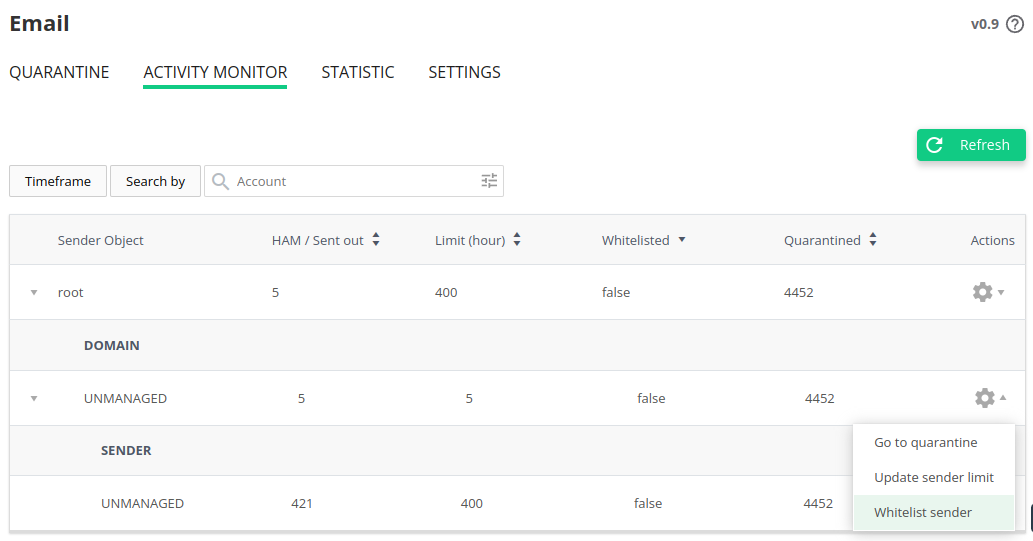
To confirm whitelisting for a particular Sender Object click Yes, add to whitelist.
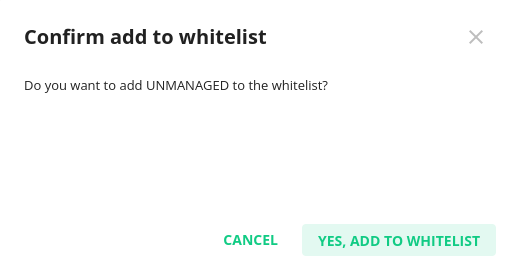
# Settings
Note
Hosting administrator only.
Go to Imunify360 → Email → Settings tab. The settings allow managing the space for quarantine and setting up limits for sending out the messages(set up a rate-limit) for all the Sender Objects adopts a 3-tier approach that is aimed to provide granular control over the outgoing messages to the administrator. An administrator can increase or decrease the space for the user's quarantine. If all space is consumed, the oldest emails in quarantine will be permanently deleted.
# Activity Monitor Settings
This is the first level of control for sender limits. The values set at this level will be default for an entire server and will be applied by default to all Sender Objects. Go to Imunify360 → Email →Settings tab. Here, set a limit on the number of emails that can be sent by a particular entity - WHM account, domain, PHP Script, or email address of a user.
- The limit is set for the number of messages within the space of the last 60 minutes.
- The limits can be applied either to a number of emails or a number of recipients.
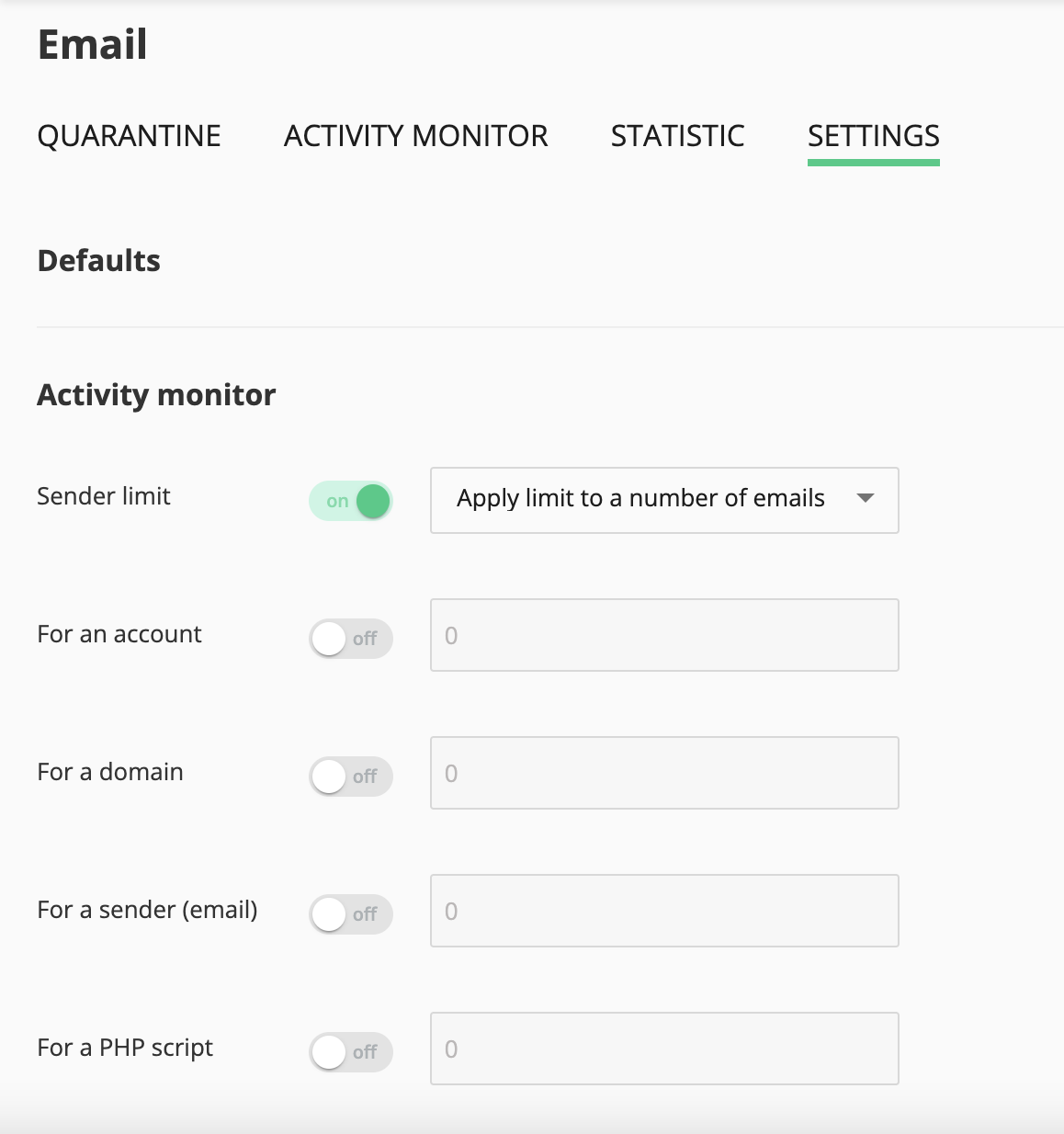
Once the values are chosen, press Save Changes to apply them.
# Quarantine Settings
You can modify the default settings for storage capacity and release limits for all accounts.
Note: If you change these settings in an individual account, the default settings will no longer apply to that account.
To revert to the default settings, refer to the CLI section.
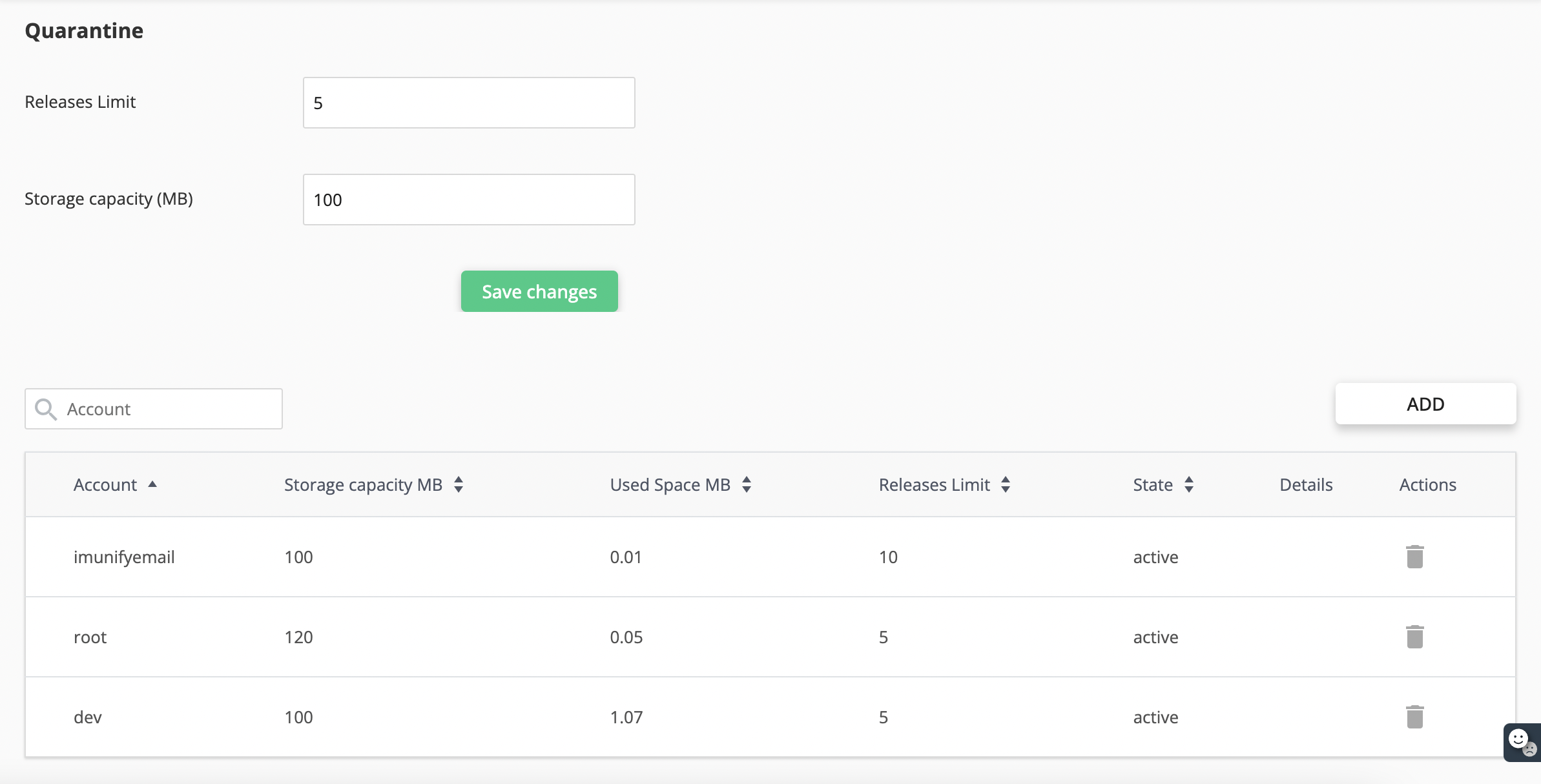
The table has the following columns:
Account — user account name
Storage Capacity MB — the space for the user's quarantine limit (default is 100 MB)
Used Space MB — the space used by files in quarantine (slight excess of the limit is possible)
Releases limit — limit for releases per hour for non-root user
State — the state of the user's quarantine.
Details — emails deleted permanently for the last hour
Actions
Purge quarantine — purge all quarantine for an account
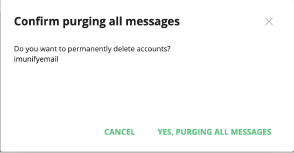
Add — change the limit of the space for the user's (account) quarantine

# Imunify Email Command Line Interface
The Command Line Interface (CLI) is designed to simplify usage of Imunify Email and as an enabler for integration with other tools and platforms.
Main command for all operations with Imunify Email:
ie-cli
# Basic usage
Imunify Email quarantine CLI application
Usage:
ie-cli [command] [arguments]
Use --help key to get list of the available commands and to get help for the particular command, e.g. ie-cli whitelist sender --help .
Available Commands:
accounts | interaction with accounts in the quarantine |
am | interaction with the Activity Monitor, same API as in ActivityMonitor UI |
emails | interaction with emails in the quarantine |
filter-settings | toggle the filter settings, without any parameters - returns the current settings |
quarantine-defaults | interaction with default settings in the Quarantine |
version | print the ImunifyEmail CLI version |
whitelist | interaction with the whitelist of authenticated users, senders and recipients |
Flags:
-h, --help | Help for ie-cli |
# Operations with emails in the quarantine
Emails marked as spam by Imunify Email are stored in the quarantine. The following section describes CLI for operating with emails.
Note
The quarantine is keeping email for various users separately, but root users can see all the emails and perform any operations on them.
Note
Almost all CLI commands support output in plain text and JSON format. For switching output to JSON use --json
# List emails in quarantine
In order to see all emails stored use the following command. By default 'root' account is used, so the command shows the whole content of the quarantine.
Command
ie-cli emails list --help
list emails in the quarantine, order by quarantined date descending
Usage:
ie-cli emails list [flags]
Flags:
-a, --account string an account name
-h, --help help for list
--json output in json format
-l, --limit int The maximum count of items to return (default 25)
-s, --since string show entries starting from [now - since] time
format: [DIGIT(s)][MODIFIER]
supported modifiers 's' - seconds, 'm' - minutes, 'h' - hours, 'd' - days, e.g. 1h, 2d
examples: 100s, 5m, 1h, 5d (default "30d")
Example
ie-cli emails list -a root --since 24h
That command shows all the quarantined emails for all accounts that have been quarantined within last 24 hours.
Output
-----------------------------------------------------------------------------------------------------------
Email_ID ef69f707-d547-4b29-b8f0-f5331821c930
Size_Bytes 8190
Account_Name mws
Recipients me@somehost.com
Subject Ge t G:eneric V1agra f:or as 1ow as $2.50 per 50 mg
----------------------------------------------------------------------------------------------------------
Email_ID faf96a73-5be4-481a-9c6c-7ab8fb2e3cf0
Size_Bytes 8534
Account_Name mws
Recipients frank@yahooo.com
Subject FWD: Want Pills V|AgR@ % Xan_a_x ^ Valiu|m| # At|v@`n \ Pn+ermin ' So+m+a lNmAL
-----------------------------------------------------------------------------------------------------------
Email_ID fbc2efd0-1808-4e54-99ce-3082708b28ee
Size_Bytes 8971
Account_Name oregdent
Recipients steve@hillcabinet.com
Subject FWD:Xanax.x Valium.m Xanax.x Vicodin.n h ogzmwggi
-----------------------------------------------------------------------------------------------------------
Max Count 3
Example with JSON as output format
ie-cli emails list -a root –-json
Output
{
"items": [
{
"email_id": "ef69f707-d547-4b29-b8f0-f5331821c930",
"size_bytes": 8190,
"account_name": "mws",
"recipients": [
"me@somehost.com"
],
"subject": "Ge t G:eneric V1agra f:or as 1ow as $2.50 per 50 mg",
"script_header": {
"raw": "",
"domain": "",
"path": ""
}
},
{
"email_id": "faf96a73-5be4-481a-9c6c-7ab8fb2e3cf0",
"size_bytes": 8534,
"account_name": "mws",
"recipients": [
"frank@yahooo.com"
],
"subject": "FWD: Want Pills V|AgR@ % Xan_a_x ^ Valiu|m| lNmAL",
"script_header": {
"raw": "",
"domain": "",
"path": ""
}
},
{
"email_id": "fbc2efd0-1808-4e54-99ce-3082708b28ee",
"size_bytes": 8971,
"account_name": "oregdent",
"recipients": [
"steve@hillcabinet.com"
],
"subject": "FWD:Xanax.x Valium.m Xanax.x Vicodin.n h ogzmwggi",
"script_header": {
"raw": "",
"domain": "",
"path": ""
}
}
],
"max_count": 3
}
# Show Email message
Root user, if needed, can see any message held in a quarantine. In order to do this email ID is needed. It can be taken from the list command above.
Note
Don’t forget to specify a user account. For root user use -a root.
Command
ie-cli emails show --id <EMAIL_ID> [-a <ACCOUNT_NAME>] [--json]
Example
ie-cli emails show --id f3367f1b-4216-4f4f-9617-f8be9f5a6e76 -a root
Output
EmailID: f3367f1b-4216-4f4f-9617-f8be9f5a6e76
SizeBytes: 8534
AccountName: mws
Sender: mws@mywebsite.com
Recipients: me@somehost.com
ReceivedDate: 1643805800
Subject: FWD: Want Pills V|AgR@ % Xan_a_x ^ Valiu|m| # At|v@`n \ Pn+ermin ' So+m+a lNmAL
Content-Transfer-Encoding: quoted-printable
Content-Type: text/html; charset="iso-8859-7"
Date: Fri, 13 Feb 2019 04:48:28 +0300
From: "wilhelmina rivard" <rivard1792@hinet.net>
MIME-Version: 1.0
Received: from [70.100.200.300] (port=56330 helo=Myaccout) by 70.100.200.300.cprapid.com with esmtpsa (TLS1.2) tls TLS_ECDHE_RSA_WITH_AES_256_GCM_SHA384 (Exim 4.94.2) (envelope-from <mws@mydomain.com>) id 1nFEym-0005TO-Qs for me@somehost.com; Wed, 02 Feb 2022 12:43:20 +0000
To: <abazis@iit.demokritos.gr>
X-ImunifyEmail-Filter-Action: reject
X-ImunifyEmail-Filter-Score: 6.1
X-Mimeole: Produced By Microsoft MimeOLE V6.00.2900.2527
X-Msmail-Priority: Normal
X-Priority: 3
X-Failed-Recipients: []
Body: PCFET0NUWVBFIGh0bWwgcHVibGljICItLy9XM0MvL0RURCBIVE1MIDQuMDEgVHJhbnNpdGlvbmFsLy9FTiIgPQoiaHR0cDovL3d3dy53My5vcmcvVFIvaHRtbDQvbG9vc2UuZHRkIj4KPEhUTUw+CjxIRUFEPgo8VElUTEU+QWxsIFlvdXIgTWVkcyBIZXJlPC9USVRMRT4KPE1FVEEgaHR0cC1lcXVpdj0zRCJDb250ZW50LXR5cGUiIGNvbnRlbnQ9M0QidGV4dC9odG1sOyA9CmNoYXJzZXQ9M0RJU08tODg1OS0xIj4KPFNUWUxFIHR5cGU9M0QidGV4dC9jc3MiPgo8IS0tIC5zdHlsZTUge2ZvbnQtZmFtaWx5OiBBcmlhbCwgSGVsdmV0aWNhLCBzYW5zLXNlcmlmOyBmb250LXNpemU6ID0KMTRweDsgfT0yMAo8IS0tIC5zdHlsZTgge2ZvbnQtZmFtaWx5OiBBcmlhbCwgSGVsdmV0aWNhLCBzYW5zLXNlcmlmOyBmb250LXNpemU6IDhweDsgPQp9PTIwCi0tPjwvU1RZTEU
# Release or Remove a message from the quarantine
Messages can be released from the quarantine and sent to recipients if they are false positives. They can also be deleted if needed to free up space.
Note
The quarantine will automatically delete the oldest messages when the user's quarantine limit is reached. The limit can be adjusted in settings.
Note
Non-root users are currently limited to releasing only 5 messages from quarantine per hour. This limit can be adjusted using the ie-cli command-line interface (CLI) tool.
# Release
Command
ie-cli emails release --ids EMAIL_ID_1,EMAIL_ID_2 -a root
Example
ie-cli emails release --ids fb7c3537-8e5e-43d8-bc66-bd954c22d587 -a root
Output
OK
# Remove
Command
ie-cli emails remove --ids fb7c3537-8e5e-43d8-bc66-bd954c22d587 -a root
Output
OK
# Accounts settings
ImunifyEmail stores emails marked as spam in a quarantine space. The space is divided into virtual subspaces for every system account. Subspace is created when the first spam message is quarantined. It is filled with spam messages for a particular account until the size limitation is reached. When the size limitation is reached most old messages will be automatically deleted.
Note
Default limit for a quarantine subspace is 100 MB.
Note
In some cases ImunifyEmail can’t attribute an email to a system account. In such cases the email will be stored under root user quarantine space.
There are command line commands for managing quarantine space.
# List all accounts in the quarantine
Command
ie-cli accounts list [--json]
Output
Name LimitBytes UsedBytes State
mysite 125829120 810692 active
dentistcenter 104857600 0 active
Max Count 2
Output (JSON)
{
"items":[
{
"name":"mysite",
"limit_bytes":125829120,
"used_bytes":810692,
"state":"active"
},
{
"name":"dentistcenter",
"limit_bytes":104857600,
"used_bytes":0,
"state":"active"
}
],
"max_count":2
}
# Edit account size limit
Sometimes it is necessary to give more (or less) space in the quarantine for some user accounts. It is possible to do using the following command.
Command
ie-cli accounts edit -a ACCOUNT_NAME [--state=active|block] [--limit=1024]
Example
ie-cli accounts edit -a mydomain --state=active --limit=8096
Output (JSON)
Name LimitBytes UsedBytes State
mws 8096 810692 active
Output
{
"name":"mws",
"limit_bytes":8096,
"used_bytes":160461,
"state":"active"
}
# Edit account releases-limit
Users' hourly releases-limit values can be adjusted according to your needs. This allows for a more dynamic and responsive management of user activity, ensuring optimal operational efficiency.
To view the current account settings, use the following command:
Command
ie-cli accounts list --name=imunifyemail
Output
Name LimitBytes UsedBytes State ReleasesLimit (hourly)
imunifyemail 104857600 8324 active 5
To modify the release limit, use the ie-cli accounts edit command followed by the --name parameter (to specify the account) and the --releases-limit parameter (to set the new limit). For example:
Command
ie-cli accounts edit --name=imunifyemail --releases-limit=50
Output
Name LimitBytes UsedBytes State ReleasesLimit (hourly)
imunifyemail 104857600 8324 active 50
# Clean all quarantine for an account
If needed all quarantine for an account can be cleaned with one command.
Command
ie-cli accounts remove -a <ACCOUNT_NAME>
Example
ie-cli accounts remove -a root
Output
OK
# Whitelisting
Imunify Email supports whitelisting configuration. It is possible to whitelist domains and/or email addresses of a sender.
Warning
When sender is whitelisted Imunify Email bypasses it’s emails without filtering. It may affect hosting reputation if a whitelisted sender will send spam.
# Available commands
In general, all whitelisting operations could be described by the next pattern:
ie-cli whitelist WHO OPERATION [value1 value2 ... valueN]
Where WHO is one of:
- authuser (only email address)
- sender (email address or domain name)
OPERATION is one of:
- add
- list
- remove
value1 valu2 ... valueN - email addresses and domains (actual for the add and remove commands)
Command
ie-cli whitelist --help
List/Add/Delete authenticated users, senders and recipients to/from whitelist.
Where :
- authenticated user could be only an email address
- sender and recipient could be one of domain or email address
Usage:
ie-cli whitelist [command]
Available Commands:
authuser operation with the whitelist of the authenticated users (email addresses)
sender operation with the whitelist of senders (email addresses and domains)
Flags:
-h, --help help for whitelist
Use "ie-cli whitelist [command] --help" for more information about a command.
# See all whitelist senders
Command
ie-cli whitelist authuser list [--json]
Output
EMAILS
1@example5.com
pp@ppp.com
qq@qq.com
me@mydomain.com
DOMAINS
No available data
Output (JSON)
{
"success": true,
"emails": [
"1@example5.com",
"pp@ppp.com",
"qq@qq.com",
"me@mydomain.com"
],
"domains": []
}
# Whitelist a sender
To whitelist a domain or/and an email address use the following command.
Command
ie-cli whitelist sender add domain.com some_email@domain.com
Output
Adding sender(s) to the whitelist:
1. domain domain.com
2. email some_email@domain.com
OK
# Remove sender from the whitelist
If needed, the sender can be removed from the whitelist. See the following commands.
Command
ie-cli whitelist sender remove domain.com
Output
Removing sender(s) from the whitelist:
1. domain domain.com
OK
# Quarantine default settings (releases limit and storage capacity)
Two commands are available: set and edit Please run with --help flag to get more info
Command
ie-cli quarantine-defaults --help
# list Command
Note: The --json flag is available to output in JSON format.
Example
ie-cli quarantine-defaults list
Output
Setting IntValue
limit_bytes 104857600
releases_limit 5
# set Command
Command
ie-cli quarantine-defaults set --help
Set default settings for accounts. Use -1 to set common default value.
Usage:
ie-cli quarantine-defaults set [flags]
Flags:
-h, --help help for set
--json output in json format
-r, --releases-limit Limit for releases per hour for non-root user
-s, --storage-capacity Limit in MB for the storage in the Quarantine for the account
Example
ie-cli quarantine-defaults set --releases-limit 50 --storage-capacity 120
That command sets the releases limit to 50 per hour and storage capacity to 120 MB.
Output
Setting IntValue
limit_bytes 125829120
releases_limit 50
# Activity Monitor
To get understanding of Activity Monitor see the next section. ie-cli provides and API to get the same information as UI does from the Activity Monitor. ie-cli allows to
- get the Activity Monitor statistics
- set/remove/update sender limits for the particular account/domain/email/script
- get/update server limits that applied by default
Command
ie-cli am --help
This subcommand interacts with the Activity Monitor to return statistics, get/set settings for
the sender objects.
Activity Monitor operates by the sender objects. Sender object is an object on behalf of which
client sends email. It could be one of: "account", "domain", "script" or "sender_email"
Usage:
ie-cli am [command]
Available Commands:
limit The limit value of sender object can be applied on particular domain, sender email and account
server-settings Operates by the server sender limit settings and allows to set default limit that is applied for all sender objects
stats stats (statistics) returns the aggregated view of senders objects with various filters
Flags:
-h, --help help for am
Use "ie-cli am [command] --help" for more information about a command.
# Usage of limit subcommand
The ie-cli am limit command is a versatile tool that enables you to assign a limit value to any sender object. This object could be an account, domain, sender email, or script. The command can be further customized with the use of specific flags and subcommands.
The set subcommand is available for use with this command. Its primary function is to establish a limit for the designated sender object(s).
In the context of the "ie-cli am limit set" command, the flags that can be used include "--id string", "--limit int", and "--so-type string".
Note
In order to set a limit, it's essential to know the sender object's id. This id can be obtained from the ie-cli am stats subcommand. For guidance on how to obtain the sender object id, please refer to the ie-cli am stats documentation provided below.
Command
ie-cli am limit set --help
Output
set limit for the sender object(s)
Usage:
ie-cli am limit set [flags]
Flags:
-h, --help help for set
--id string The id of sender object
--limit int The limit value, 0 means unlimited (default -1)
--so-type string supported values: [account domain sender_email script]
The utilization of the limit subcommand varies according to the sender-object types (--so-type);
Command usage with --so-type="account" for set limit
ie-cli am limit set --id="11111111-1111-1111-1111-11111111111" --limit=3 --so-type="account"
Command usage with --so-type="domain" for set limit
ie-cli am limit set --id="22222222-2222-2222-2222-222222222222" --limit=5 --so-type="domain"
Command usage with --so-type="sender_email" for set limit
ie-cli am limit set --id="33333333-3333-3333-3333-333333333333" --limit=7 --so-type="sender_email"
Output
OK
Note
Modifications can be tracked by navigating through the User Interface (UI) via Imunify360 -> Email -> Activity Monitor.
# Usage of server-settings subcommand
The ie-cli am server-settings command is designed to manage server sender limit settings, allowing you to establish a default limit that is applied to any sender object by default. This command can be further customized with the use of specific flags and subcommands.
The ie-cli am server-settings set command is designed to modify the server sender limit settings. This command can be paired with specific flags to establish the limit mode and eliminate limits for certain sender objects.
The --limit-mode int flag is utilized to define the limit mode. The limit mode can be either 1 or 2, where 1 signifies limit mode by sender and 2 denotes limit mode by the number of recipients.
To eliminate the limit for any sender object, a value of 0 can be used. For instance, to remove the limit for an account, the --account=0 command can be employed. A value of 0 indicates that the sender object will have no restrictions, effectively rendering it unlimited.
Additional flags encompass --account int, --domain int, --script int, and --sender-email int. These are utilized to establish the threshold for any account, domain, script, or sender email, correspondingly. The default value for these flags is set to -1.
The existing server-settings can be accessed by utilizing the ie-cli am server-settings command.
Command
ie-cli am server-settings
Output
{
"account": 0,
"domain": 1,
"limit_mode": 1,
"script": 0,
"sender_email": 0
}
To establish the limit mode to 2 (limit by the number of recipients) and designate any limit for a domain, the subsequent command could be utilized: ie-cli am server-settings set --limit-mode=2 --domain=100.
Command
ie-cli am server-settings set --limit-mode=2 --domain=100
Output
New server settings is:
{
"account": 0,
"domain": 100,
"limit_mode": 2,
"script": 0,
"sender_email": 0
}
For instance, to configure the limit mode to 1 (limit by sender) and eliminate the limit for any account, the following command could be employed: ie-cli am server-settings set --limit-mode=1 --account=0.
Command
ie-cli am server-settings set --limit-mode=1 --account=0
Output
New server settings is:
{
"account": 0,
"domain": 100,
"limit_mode": 1,
"script": 0,
"sender_email": 0
}
# Usage of stats subcommand
The ie-cli am stats command provides a consolidated view of sender objects, complete with a variety of filters. This command can be paired with specific flags to refine the results.
The flags include --account-name string, --domain string, --limit int, --offset int, --script-name string, --sender-email string, and --since string. These are employed to filter by account name, domain, limit the quantity of results, set the offset for results, filter by script name, filter by sender email, and set the duration in seconds that has elapsed from the flag value until the present moment, respectively.
The --limit int flag also indicates that the limit applied pertains solely to the number of accounts in the response, with a default of 25.
The --since string flag defaults to a value of 1 hour - 1h.
Note
The functionality mirrors that of the ActivityMonitor user interface.
Command
ie-cli am stats --help
stats (statistics) returns the aggregated view of senders objects with various filters
Usage:
ie-cli am stats [flags]
Flags:
--account-name string Account name to filter
--domain string Domain to filter
-h, --help help for stats
--limit int How many results to return (pagination). The limit applied only for number of accounts in response (default 25)
--offset int From which offset results to return (pagination)
--script-name string Script name to filter
--sender-email string Sender email to filter
--since string show entries starting from [now - since] time
format: [DIGIT(s)][MODIFIER]
supported modifiers 's' - seconds, 'm' - minutes, 'h' - hours, 'd' - days, e.g. 1h, 2d
examples: 100s, 5m, 1h, 5d (default "1h")
By using the stats command directly, all sender objects are returned as follows. The --since flag can be used to retrieve sender objects within a certain period of time.
Command
ie-cli am stats --since 10h
Output
{
"accounts": [
{
"domains": [
{
"account_id": "11111111-1111-1111-1111-11111111111",
"exclusion": false,
"id": "22222222-2222-2222-2222-222222222222",
"limit": 0,
"messages": 1,
"name": "domain.com",
"quarantined": 1,
"rateLimited": false,
"sender_emails": [
{
"account_id": "11111111-1111-1111-1111-11111111111",
"domain_id": "22222222-2222-2222-2222-222222222222",
"exclusion": false,
"id": "33333333-3333-3333-3333-333333333333",
"limit": 0,
"messages": 1,
"name": "test@domain.com",
"quarantined": 1,
"rateLimited": false,
"whitelisted": false
}
],
"whitelisted": false
},
],
"exclusion": false,
"id": "11111111-1111-1111-1111-11111111111",
"limit": 0,
"messages": 1,
"name": "domain",
"quarantined": 1,
"rateLimited": false,
"scripts": null,
"whitelisted": false
}
]
}
Command usage with --sender-email for get sender-object id
ie-cli am stats --sender-email=test@domain.com
Command usage with --account-name for get sender-object id
ie-cli am stats --account-name=domain --since 30d
Output
{
"accounts": [
{
"domains": [
{
"account_id": "11111111-1111-1111-1111-11111111111",
"exclusion": false,
"id": "22222222-2222-2222-2222-222222222222",
"limit": 0,
"messages": 1,
"name": "domain.com",
"quarantined": 1,
"rateLimited": false,
"sender_emails": [
{
"account_id": "11111111-1111-1111-1111-11111111111",
"domain_id": "22222222-2222-2222-2222-222222222222",
"exclusion": false,
"id": "33333333-3333-3333-3333-333333333333",
"limit": 0,
"messages": 1,
"name": "test@domain.com",
"quarantined": 1,
"rateLimited": false,
"whitelisted": false
}
],
"whitelisted": false
},
],
"exclusion": false,
"id": "11111111-1111-1111-1111-11111111111",
"limit": 0,
"messages": 1,
"name": "domain",
"quarantined": 1,
"rateLimited": false,
"scripts": null,
"whitelisted": false
}
]
}
# Uninstallation
To remove Imunify Email from your system, you need to disable the corresponding option in your CLN account. That will disable Imunify Email on the server, but rpm packages still will be presented. To remove them as well, execute the following command as root:
Command
yum autoremove imunifyemail
This command ensures the removal of all associated components related to Imunify Email from your system.



